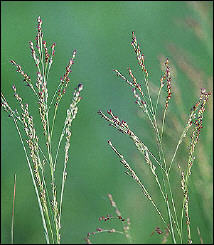Switchgrass shows promise for ethanol production: study

A large-scale trial of switchgrass suggests that the crop may be a more viable plant source of biofuel than previously thought, according to a study released Monday.
A five year trial of the native North American prairie grass on
farmland in the Midwestern United States revealed that the crop produces 540
percent more renewable energy than energy consumed in its production.
Previous estimates, based on small scale research plots, suggested the grass
would yield a net energy production of about 343 percent. Net energy
production is considered an important measure of sustainability.
"When you go to the farm scale, results are better than predicted," said
Kenneth Vogel, a research geneticist with the US Department of Agriculture's
Agricultural Research Service based at the University of Nebraska in
Lincoln.
"There is a lot of potential to make further improvements," he added. "The
plants used in this trial were developed for pasture and conservation. We're
now breeding plants specifically to be used as energy crops."
Global biofuel production has tripled from 4.8 billion gallons in 2000 to
about 16 billion in 2007, but still accounts for less than three percent of
the global transportation fuel supply, according to US Department of
Agriculture figures, as quoted in Amber Waves, a USDA publication.
Concerns about energy security, climate change and soaring oil prices drove
policymakers and scientists to develop alternative energy sources that would
allow them to break their dependence on foreign oil.
The unprecedented run-up in oil prices in the past six years has kept the
pressure on, but rising demand for biofuels, among other things, has led to
higher prices for some of the commodities that are currently used to make
biofuel - such as corn and vegetable oils.
In the case of corn, it is thought that competing food and feed
demands on grain supplies and prices will eventually limit expansion of
grain-ethanol capacity, so researchers have begun to explore alternative
plant sources for second-generation or cellulosic biofuels.
Switchgrass like some other fast-growing, high-fibre grasses and wood
by-products is rich in cellulose, a material that can be readily converted
into sugar and fermented to make ethanol.
It is thought that cellulosic biofuels made from perennial plants such as
switchgrass will require fewer agricultural inputs than annual crops such as
corn, and will offer better yields, lowering the price of bio-ethanol.
Scientists are also hopeful that they can deliver better yields and
efficiencies through improvements in crop management and by breeding strains
of switchgrass better suited to be converted to ethanol.
In the paper in the Proceedings of the National Academy of Sciences, the
researchers reported that newer breeds of switchgrass have yields 20-30
percent higher than earlier strains.
© 2008 AFP